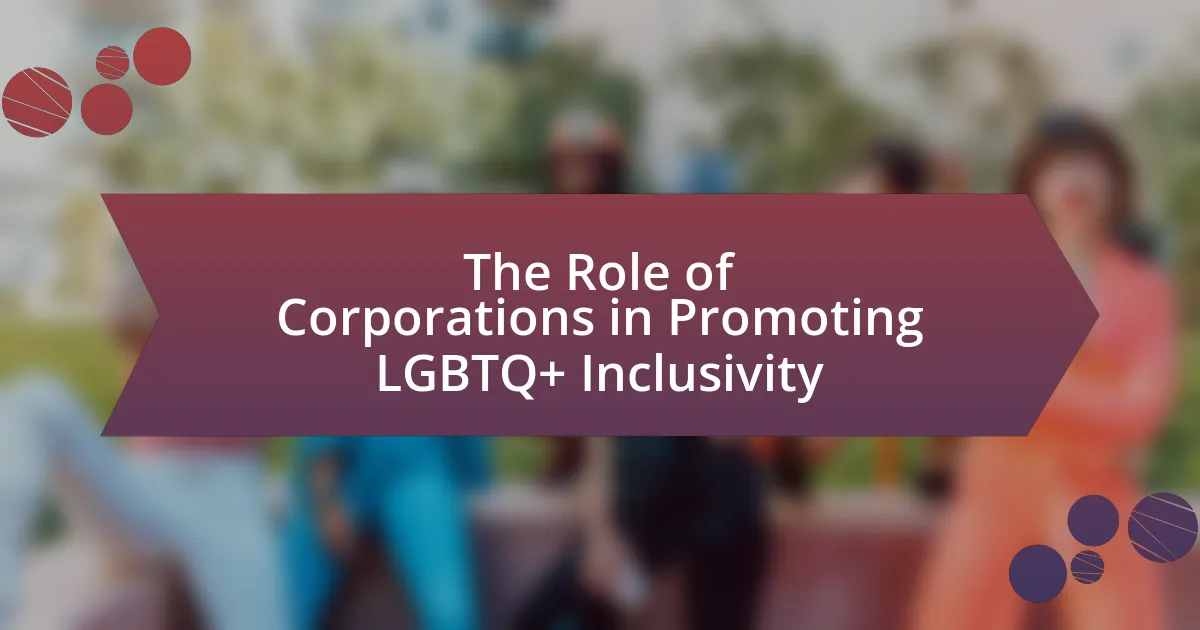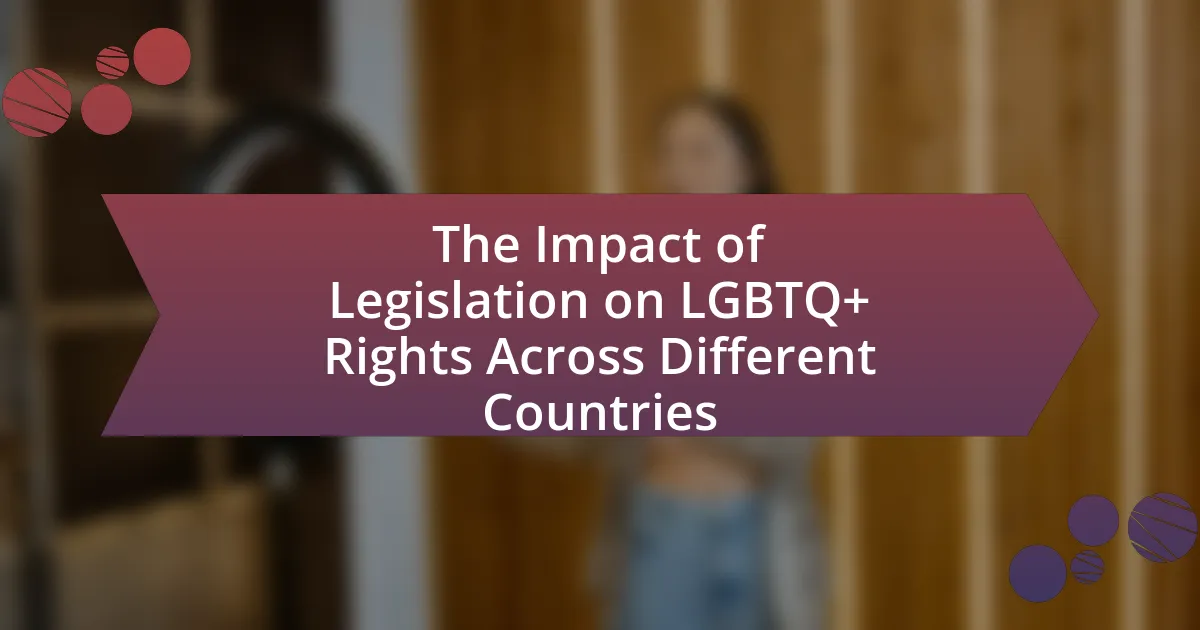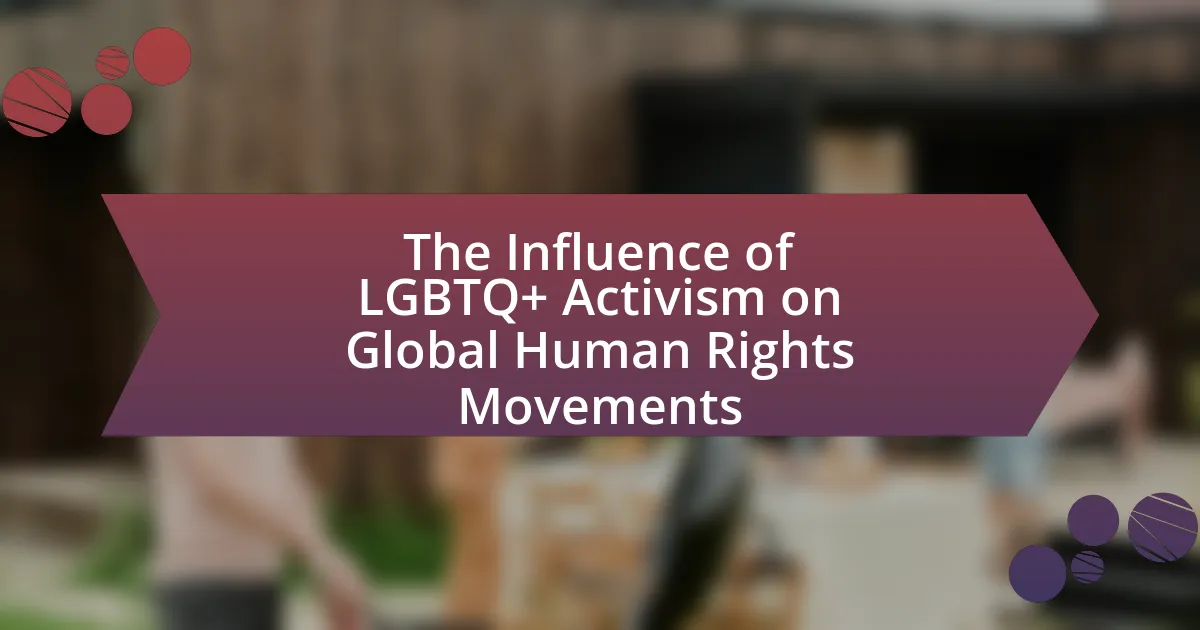Grassroots movements are collective actions initiated by ordinary people at the local level to drive social or political change, often in response to specific community issues. This article explores the characteristics, importance, and impact of grassroots movements in a democratic society, highlighting their decentralized nature and community-driven approach. It examines historical examples, such as the Civil Rights Movement, and contemporary movements like Black Lives Matter, illustrating how local activism can influence national policy. Additionally, the article addresses the challenges faced by grassroots movements, including funding limitations and legal obstacles, while providing insights into strategies for mobilization and community engagement.
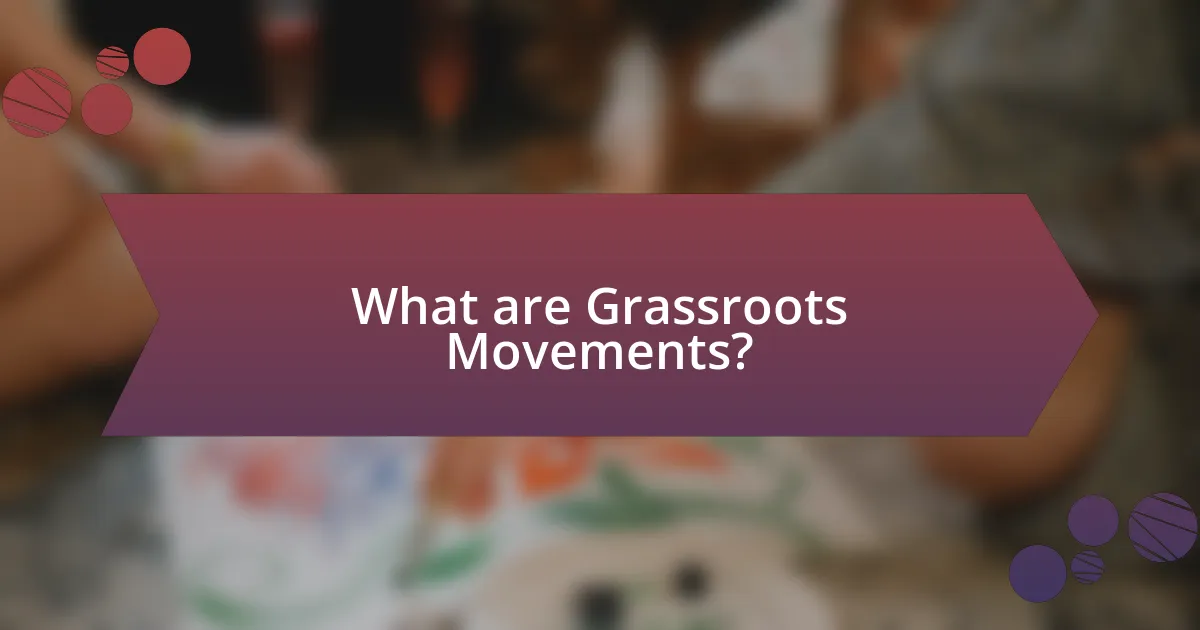
What are Grassroots Movements?
Grassroots movements are collective actions initiated by ordinary people at the local level to effect social or political change. These movements often arise in response to specific community issues, mobilizing individuals to advocate for their rights or interests, thereby influencing broader national policies. For example, the Civil Rights Movement in the United States began as grassroots activism, where local communities organized protests and campaigns that ultimately led to significant legislative changes, such as the Civil Rights Act of 1964. This demonstrates how grassroots movements can successfully shape national policy through localized efforts and community engagement.
How do Grassroots Movements differ from traditional activism?
Grassroots movements differ from traditional activism primarily in their structure and approach, as grassroots movements are typically decentralized and community-driven, while traditional activism often relies on established organizations and top-down leadership. Grassroots movements mobilize individuals at the local level, emphasizing participation and direct action, which contrasts with traditional activism that may focus on formal campaigns and institutional advocacy. For example, the Civil Rights Movement in the 1960s showcased grassroots organizing through local community efforts, while traditional activism often involved larger, hierarchical organizations like the NAACP. This distinction highlights how grassroots movements can adapt quickly to local needs and foster a sense of ownership among participants, leading to more immediate and localized impact.
What are the key characteristics of Grassroots Movements?
Grassroots movements are characterized by their community-driven nature, emphasizing local participation and activism. These movements typically arise from the collective efforts of individuals at the local level who seek to address specific social, political, or environmental issues. They often rely on volunteer efforts and grassroots organizing techniques, such as door-to-door campaigning and community meetings, to mobilize support and raise awareness.
Additionally, grassroots movements prioritize inclusivity and democratic participation, allowing diverse voices to contribute to the movement’s goals. They frequently utilize social media and digital platforms to amplify their message and connect with a broader audience. Historical examples, such as the Civil Rights Movement in the United States, demonstrate how grassroots efforts can lead to significant national policy changes, showcasing the effectiveness of local activism in shaping larger societal outcomes.
Why are Grassroots Movements important in a democratic society?
Grassroots movements are important in a democratic society because they empower citizens to influence political decisions and advocate for social change. These movements facilitate direct participation in the democratic process, allowing individuals to voice their concerns and priorities, which can lead to significant policy shifts. For instance, the Civil Rights Movement in the United States, driven by grassroots activism, resulted in landmark legislation such as the Civil Rights Act of 1964, which outlawed discrimination based on race, color, religion, sex, or national origin. This demonstrates how grassroots efforts can mobilize communities, raise awareness, and ultimately shape national policy in alignment with the collective will of the people.
What role do local communities play in Grassroots Movements?
Local communities serve as the foundational backbone of grassroots movements by mobilizing individuals, resources, and local knowledge to advocate for change. These communities often identify specific issues affecting their lives, which drives collective action and fosters a sense of solidarity among members. For instance, the Civil Rights Movement in the United States was largely propelled by local communities organizing protests and sit-ins, demonstrating their critical role in shaping national discourse and policy. Additionally, research by the Stanford Social Innovation Review highlights that grassroots movements led by local communities are more effective in influencing policy changes because they leverage local networks and relationships, making their advocacy efforts more relatable and impactful.
How do local issues inspire Grassroots Movements?
Local issues inspire grassroots movements by highlighting specific community needs and injustices that require immediate attention. These movements often emerge in response to problems such as environmental degradation, social inequality, or inadequate public services, motivating individuals to organize and advocate for change. For instance, the Flint water crisis galvanized local residents to mobilize against government negligence, leading to national awareness and policy discussions on water safety and infrastructure. Such grassroots efforts demonstrate how localized concerns can resonate broadly, influencing national policy and encouraging civic engagement.
What strategies do local activists use to mobilize communities?
Local activists use strategies such as community organizing, coalition building, and grassroots outreach to mobilize communities. Community organizing involves identifying local leaders and engaging residents in discussions about their needs and concerns, fostering a sense of ownership and empowerment. Coalition building brings together diverse groups to amplify voices and resources, enhancing the impact of their efforts. Grassroots outreach includes door-to-door canvassing, social media campaigns, and public events to raise awareness and encourage participation, effectively reaching a wider audience. These strategies have been shown to increase civic engagement and influence local policy decisions, as evidenced by successful campaigns like the Fight for $15 movement, which mobilized thousands to advocate for higher minimum wages across various cities.
How do Grassroots Movements influence national policy?
Grassroots movements influence national policy by mobilizing community members to advocate for change, thereby creating pressure on policymakers. These movements often raise awareness about specific issues, such as climate change or social justice, which can lead to increased public support and political action. For instance, the Civil Rights Movement in the 1960s successfully pushed for the Civil Rights Act of 1964 through widespread protests and grassroots organizing, demonstrating how local activism can lead to significant national legislative changes. Additionally, contemporary movements like Black Lives Matter have influenced national conversations around policing and racial equity, resulting in policy proposals at both state and federal levels.
What mechanisms allow local activism to reach national policymakers?
Local activism reaches national policymakers through mechanisms such as grassroots organizing, digital advocacy, and coalition-building. Grassroots organizing mobilizes community members to advocate for specific issues, creating a collective voice that can attract national attention. Digital advocacy leverages social media platforms to amplify local concerns, enabling activists to engage with a broader audience and policymakers directly. Coalition-building involves forming alliances with other organizations, enhancing the reach and impact of local initiatives, which can lead to national policy discussions. For instance, the Women’s March in 2017 began as a local event but quickly gained national traction, influencing policymakers on issues like women’s rights and healthcare.
How have historical Grassroots Movements shaped current policies?
Historical grassroots movements have significantly influenced current policies by mobilizing communities to advocate for social change, leading to legislative reforms. For instance, the Civil Rights Movement of the 1960s, characterized by grassroots activism, resulted in landmark legislation such as the Civil Rights Act of 1964 and the Voting Rights Act of 1965, which dismantled institutional racism and expanded voting rights. Similarly, the environmental movement, particularly the Earth Day initiative launched in 1970, raised public awareness and led to the establishment of the Environmental Protection Agency and the passing of key environmental laws like the Clean Air Act and the Clean Water Act. These movements demonstrate how localized efforts can create a ripple effect, shaping national policies that address systemic issues and reflect the demands of the populace.

What challenges do Grassroots Movements face?
Grassroots movements face significant challenges, including limited funding, organizational fragmentation, and resistance from established political structures. Limited funding restricts their ability to mobilize resources effectively, as many rely on small donations and volunteer efforts. Organizational fragmentation often leads to a lack of cohesion and unified messaging, making it difficult to achieve common goals. Additionally, established political structures may resist grassroots initiatives, viewing them as threats to the status quo, which can result in pushback or attempts to undermine their efforts. These challenges hinder the effectiveness and sustainability of grassroots movements in influencing national policy.
How do funding and resources impact Grassroots Movements?
Funding and resources significantly impact grassroots movements by determining their operational capacity and outreach effectiveness. Adequate funding allows grassroots organizations to mobilize volunteers, conduct outreach campaigns, and sustain long-term initiatives. For instance, the 2018 March for Our Lives movement, which advocated for gun control, was bolstered by substantial donations exceeding $3 million, enabling extensive national visibility and engagement. Conversely, limited resources can hinder a movement’s ability to organize events, communicate messages, and influence policy effectively, as seen in smaller initiatives that struggle to gain traction without financial support. Thus, the availability of funding and resources directly correlates with the success and sustainability of grassroots movements.
What are common funding sources for Grassroots Movements?
Common funding sources for grassroots movements include individual donations, crowdfunding platforms, small grants from foundations, and membership fees. Individual donations often come from community members who support the cause, while crowdfunding platforms like GoFundMe allow movements to reach a wider audience for financial support. Small grants from foundations, such as the Ford Foundation or the Open Society Foundations, provide targeted funding for specific initiatives. Membership fees contribute to the sustainability of grassroots organizations by creating a base of financial support from engaged participants. These funding sources are essential for grassroots movements to mobilize resources and amplify their impact on local and national policy.
How can limited resources hinder the effectiveness of Grassroots Movements?
Limited resources can significantly hinder the effectiveness of grassroots movements by restricting their ability to mobilize, communicate, and sustain efforts. Grassroots movements often rely on community engagement and volunteer participation, which can be diminished when financial, human, or material resources are scarce. For instance, a study by the National Democratic Institute found that movements with limited funding struggle to organize events, reach wider audiences, and maintain momentum, ultimately leading to reduced visibility and impact. Additionally, insufficient resources can limit access to essential tools such as technology for communication and outreach, further isolating these movements from potential supporters and allies.
What legal and political obstacles do Grassroots Movements encounter?
Grassroots movements encounter significant legal and political obstacles, including restrictive laws, lack of access to funding, and political opposition. Restrictive laws can include regulations on protests, campaign financing, and lobbying that limit the ability of grassroots organizations to mobilize effectively. For instance, many jurisdictions impose stringent permit requirements for public demonstrations, which can hinder grassroots activism. Additionally, grassroots movements often struggle with limited access to funding sources, as traditional funding avenues may favor established organizations over newer, community-based initiatives. Political opposition from established political entities can also pose challenges, as these entities may seek to undermine or discredit grassroots efforts to maintain their power. These obstacles collectively impede the ability of grassroots movements to influence national policy effectively.
How do laws and regulations affect Grassroots activism?
Laws and regulations significantly influence grassroots activism by either enabling or constraining the activities of local movements. For instance, laws that protect the right to assemble and protest empower grassroots organizations to mobilize support and advocate for change, as seen in the Civil Rights Movement, where legal protections facilitated mass demonstrations. Conversely, restrictive laws, such as those imposing heavy fines for protests or requiring permits that are difficult to obtain, can hinder grassroots efforts, as evidenced by recent legislation in various states aimed at limiting protest activities. These legal frameworks shape the strategies and effectiveness of grassroots activism, determining how movements can operate within the legal landscape.
What strategies can activists use to navigate these challenges?
Activists can navigate challenges by employing strategies such as building coalitions, utilizing social media for outreach, and engaging in community education. Building coalitions allows activists to pool resources and amplify their voices, which has been shown to increase the effectiveness of campaigns, as seen in the success of the Civil Rights Movement. Utilizing social media enables activists to reach a broader audience quickly, facilitating rapid mobilization and awareness, evidenced by the viral nature of movements like #MeToo. Engaging in community education fosters informed citizenry, empowering individuals to advocate for change, which has been crucial in local initiatives that have influenced national policy, such as environmental justice campaigns.
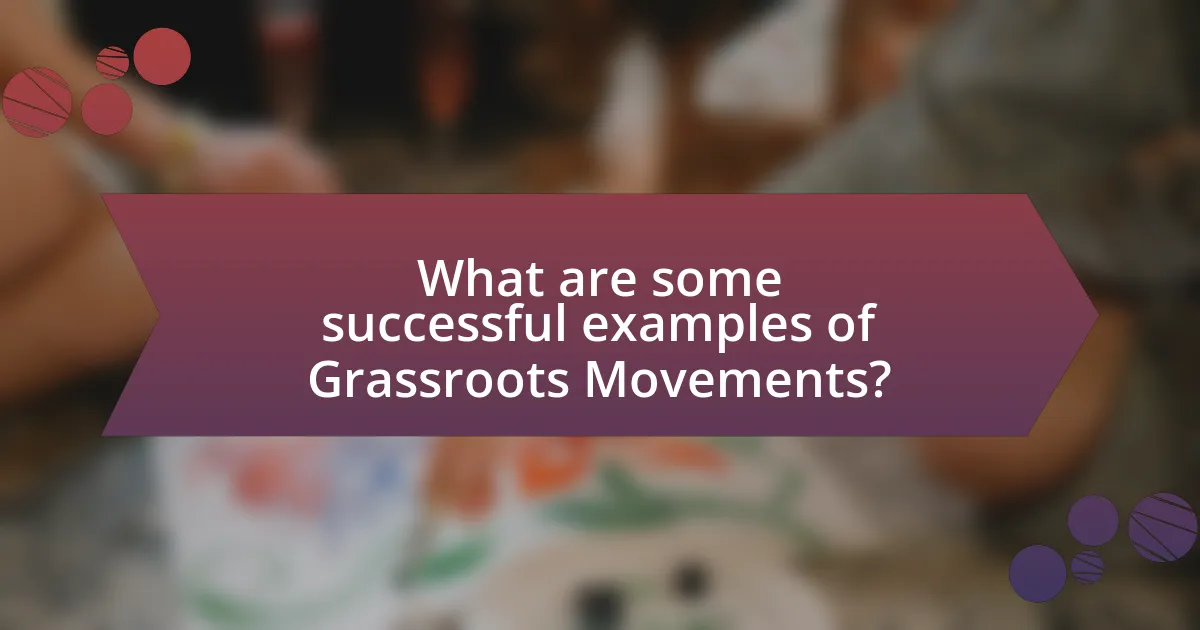
What are some successful examples of Grassroots Movements?
Successful examples of grassroots movements include the Civil Rights Movement in the United States, which effectively mobilized local communities to challenge racial segregation and discrimination, leading to significant legislative changes such as the Civil Rights Act of 1964. Another example is the environmental movement, particularly the grassroots efforts that led to the establishment of Earth Day in 1970, which raised awareness about environmental issues and resulted in the creation of the Environmental Protection Agency. Additionally, the Women’s Suffrage Movement successfully organized local campaigns that culminated in the passage of the 19th Amendment in 1920, granting women the right to vote. These movements demonstrate how localized activism can influence national policy and effect substantial social change.
How did the Civil Rights Movement exemplify Grassroots activism?
The Civil Rights Movement exemplified grassroots activism by mobilizing local communities to challenge systemic racism and advocate for civil rights. Activists organized protests, sit-ins, and voter registration drives, often led by local leaders such as Martin Luther King Jr., Rosa Parks, and grassroots organizations like the Student Nonviolent Coordinating Committee (SNCC). These efforts were crucial in raising awareness and influencing national policy, as seen in the passage of the Civil Rights Act of 1964 and the Voting Rights Act of 1965, which were direct outcomes of sustained local activism and pressure. The movement’s reliance on community involvement and local leadership demonstrated how grassroots efforts can effectively drive significant social and political change.
What tactics were used to mobilize support during the Civil Rights Movement?
The Civil Rights Movement utilized various tactics to mobilize support, including grassroots organizing, nonviolent protests, and strategic alliances. Grassroots organizing involved local communities forming groups to advocate for civil rights, exemplified by organizations like the Student Nonviolent Coordinating Committee (SNCC), which engaged young activists in direct action. Nonviolent protests, such as sit-ins and marches, were pivotal; the 1963 March on Washington, which drew over 250,000 participants, highlighted the demand for racial equality and garnered national attention. Strategic alliances with religious groups, labor unions, and other civil rights organizations expanded the movement’s reach and resources, facilitating broader support across diverse demographics. These tactics collectively contributed to significant legislative changes, including the Civil Rights Act of 1964 and the Voting Rights Act of 1965.
What lasting impacts did the Civil Rights Movement have on national policy?
The Civil Rights Movement significantly influenced national policy by leading to the enactment of landmark legislation aimed at ending racial discrimination. Key legislative achievements include the Civil Rights Act of 1964, which prohibited discrimination based on race, color, religion, sex, or national origin, and the Voting Rights Act of 1965, which aimed to eliminate barriers to voting for African Americans. These laws not only transformed social norms but also established a legal framework for future civil rights protections, reinforcing the principle of equality under the law. The movement’s advocacy for justice and equality also inspired subsequent grassroots movements, shaping policies related to gender equality, disability rights, and LGBTQ+ rights, thereby creating a broader legacy of social justice in American policy.
What lessons can be learned from recent Grassroots Movements?
Recent grassroots movements demonstrate the power of community organization in influencing national policy. These movements, such as the Black Lives Matter and climate action protests, highlight the effectiveness of mobilizing local voices to address systemic issues. For instance, the Black Lives Matter movement has led to significant policy discussions around police reform in various cities, showcasing how localized activism can prompt broader legislative changes. Additionally, the youth-led climate strikes have pressured governments worldwide to adopt more aggressive climate policies, illustrating that grassroots efforts can shift political agendas. These examples underscore the importance of grassroots activism in shaping public discourse and policy outcomes.
How did the Women’s March influence public discourse and policy?
The Women’s March significantly influenced public discourse and policy by mobilizing millions to advocate for women’s rights and social justice, thereby amplifying issues such as gender equality, reproductive rights, and racial justice. This large-scale demonstration, which took place on January 21, 2017, brought together diverse groups and highlighted systemic inequalities, leading to increased visibility and discussion of these topics in mainstream media and political arenas. As a result, the Women’s March catalyzed legislative efforts, such as the introduction of the Women’s Health Protection Act and various state-level initiatives aimed at protecting reproductive rights, demonstrating a direct link between grassroots activism and policy change.
What role did social media play in the success of recent Grassroots Movements?
Social media has been instrumental in the success of recent grassroots movements by facilitating rapid communication, mobilization, and awareness. Platforms like Twitter, Facebook, and Instagram allow activists to share information instantly, organize events, and reach a broader audience, which has been evident in movements such as Black Lives Matter and the Women’s March. For instance, the Black Lives Matter movement gained significant traction through viral hashtags and posts that highlighted systemic racism, leading to widespread protests and policy discussions. According to a study by the Pew Research Center, 69% of Americans believe social media is an effective tool for political activism, underscoring its role in shaping public discourse and influencing national policy.
What practical steps can individuals take to support Grassroots Movements?
Individuals can support grassroots movements by actively participating in local initiatives, volunteering time, and donating resources. Engaging in community events, such as town hall meetings or rallies, allows individuals to amplify the voices of grassroots organizations. Volunteering for campaigns or local advocacy groups provides essential manpower and skills that these movements often lack. Financial contributions, no matter how small, can significantly impact the sustainability of grassroots efforts, as many rely on donations to fund their activities. Research indicates that grassroots movements can effectively influence national policy, as seen in the Civil Rights Movement, which utilized local activism to achieve significant legislative changes.
How can community members get involved in local activism?
Community members can get involved in local activism by participating in grassroots organizations, attending town hall meetings, and volunteering for local campaigns. Grassroots organizations often focus on specific issues, allowing individuals to contribute their time and skills to causes they are passionate about. Town hall meetings provide a platform for community members to voice their concerns and influence local policy decisions. Volunteering for local campaigns, whether for political candidates or advocacy groups, helps amplify community voices and fosters collective action. Engaging in these activities not only strengthens community ties but also plays a crucial role in shaping local and national policies through active participation.
What resources are available for those looking to start a Grassroots Movement?
To start a grassroots movement, individuals can access various resources including community organizing toolkits, online platforms for mobilization, and training programs. Community organizing toolkits, such as those provided by the Industrial Areas Foundation, offer step-by-step guidance on building coalitions and engaging local stakeholders. Online platforms like Change.org and Facebook Groups facilitate outreach and mobilization efforts, allowing organizers to connect with supporters and share information rapidly. Additionally, organizations like the Grassroots Institute provide training programs that equip activists with skills in advocacy, fundraising, and strategic planning, essential for effective grassroots campaigning. These resources collectively empower individuals to initiate and sustain impactful grassroots movements.



